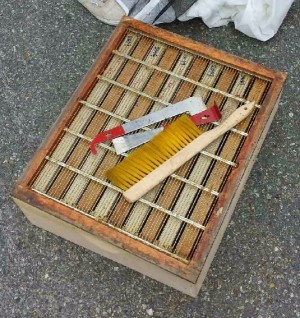The bees are living the good life. 
At least they seem to be. It’s high summer and they’re producing well, which means it’s time to start messing with them. On our most recent trip in, the plan of action was to take stock of life in the hive and, if all was well, install a honey box.
A honey box is a slightly squatter version of the boxes the bees live in. The main difference is that it’s separated from the rest of the hive by a queen excluder, a sheet of metal mesh that the worker bees can fit through but the larger queen bee can’t. That means no eggs can be laid past it, and it can be devoted to honey. Not all beekeepers do this, but it seems a whole lot easier to me. Here’s ours: the excluder will obviously go under it when we place it on top of the hive.
Our first order of business was to pretty up one of our old honey boxes. This meant scraping away all the propolis. Propolis is a hard, waxy substance (not to be confused with wax) that bees make to cement their hive together.
 My friend Tommy, of previous mulberry
My friend Tommy, of previous mulberry
fame, was visiting, so we set him to work scraping propolis off of the honey box and frames.
Poor guy. It was his birthday.
We went to the zoo afterward, though, so it was alright.
Propolis is popular as a dietary supplement and all-around healer. We saved all of our scrapings in an envelope that I put… somewhere. As soon as I find it I’ll try concocting a balm.
Once the honey box was prepped, we donned our suits. Kim always wears a full suit, and we managed to get Tommy fully outfitted. I always wear a full coat, veil, and gloves, but the rest of my outfit is a little more improvised.
 I had already tucked my jeans into my socks when we discovered some holes worn through in a particularly bee-vulnerable area. I didn’t want to go all the way home for new pants, and I certainly didn’t want inner thigh stings. We had a roll of masking tape in with the equipment, and when needs must…
I had already tucked my jeans into my socks when we discovered some holes worn through in a particularly bee-vulnerable area. I didn’t want to go all the way home for new pants, and I certainly didn’t want inner thigh stings. We had a roll of masking tape in with the equipment, and when needs must…
I wasn’t doing much with my dignity, anyway.
All passages to tender flesh sealed, we opened up the hive and took a look around. The bees have been producing famously. The queen is laying eggs at a good rate and the workers have started making honey. A couple of the frames were already noticeably heavy with it. With any luck they’ll take this new honey box and run with it.
 The last few times we’ve been able to find the queen, but this time she was hiding. This isn’t particularly worrying – there are thousands of little guys crawling around in there, and you can’t let yourself get down just because you didn’t find a specific one. It’s mainly good to find her because it shows she’s active, but with all the eggs and larvae present, it’s easy to intuit.
The last few times we’ve been able to find the queen, but this time she was hiding. This isn’t particularly worrying – there are thousands of little guys crawling around in there, and you can’t let yourself get down just because you didn’t find a specific one. It’s mainly good to find her because it shows she’s active, but with all the eggs and larvae present, it’s easy to intuit.
We also know she’s doing well because we haven’t found any queen cells. These are big, peanut-shaped protrusions on the frame, and each one holds a larva that’s being fed royal jelly – the goop that gives a queen that special queen flair (and ability to lay a whole hive’s worth of eggs). One of these larva will emerge before the others and, as her first royal act, she will murder all her proto-queen sisters in the womb. Bees are rough. This can happen when the previous queen is dead or just not very good at her job, so a lack of queen cells is a nice vote of confidence from the colony as a whole.
Queen cells may also be laid in preparation for a swarm. Bees swarm when they’ve filled up their hive – the existing queen leaves, taking roughly half the population with her to seek greener pastures. The remaining colony stays behind with a freshly hatched queen. Our plan, if this does happen, is to steal the new queen before the swarm and raise her up separately in her own little queen nook. This way we’ll have an extra queen in our pocket if ours suddenly dies or a neighboring beekeeper loses theirs and calls in a favor.
filled up their hive – the existing queen leaves, taking roughly half the population with her to seek greener pastures. The remaining colony stays behind with a freshly hatched queen. Our plan, if this does happen, is to steal the new queen before the swarm and raise her up separately in her own little queen nook. This way we’ll have an extra queen in our pocket if ours suddenly dies or a neighboring beekeeper loses theirs and calls in a favor.
It’s also another interesting way to play God.
I’m cross-posting this bee update on my community garden’s blog. Go check it out!
Very cool!
LikeLike
Thanks, Zach!
LikeLike
Pingback: The Road to Honey | Liz Baessler | WORLD ORGANIC NEWS
Pingback: Uncle Beth’s Old Fashioned Mead | Liz Baessler